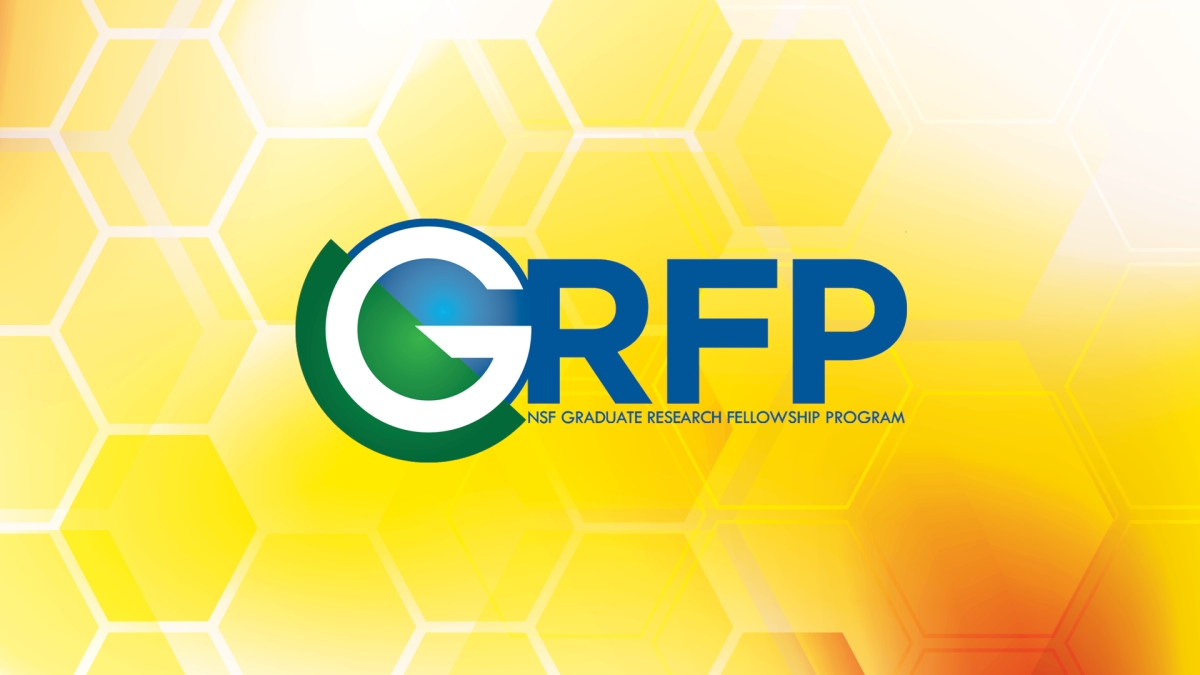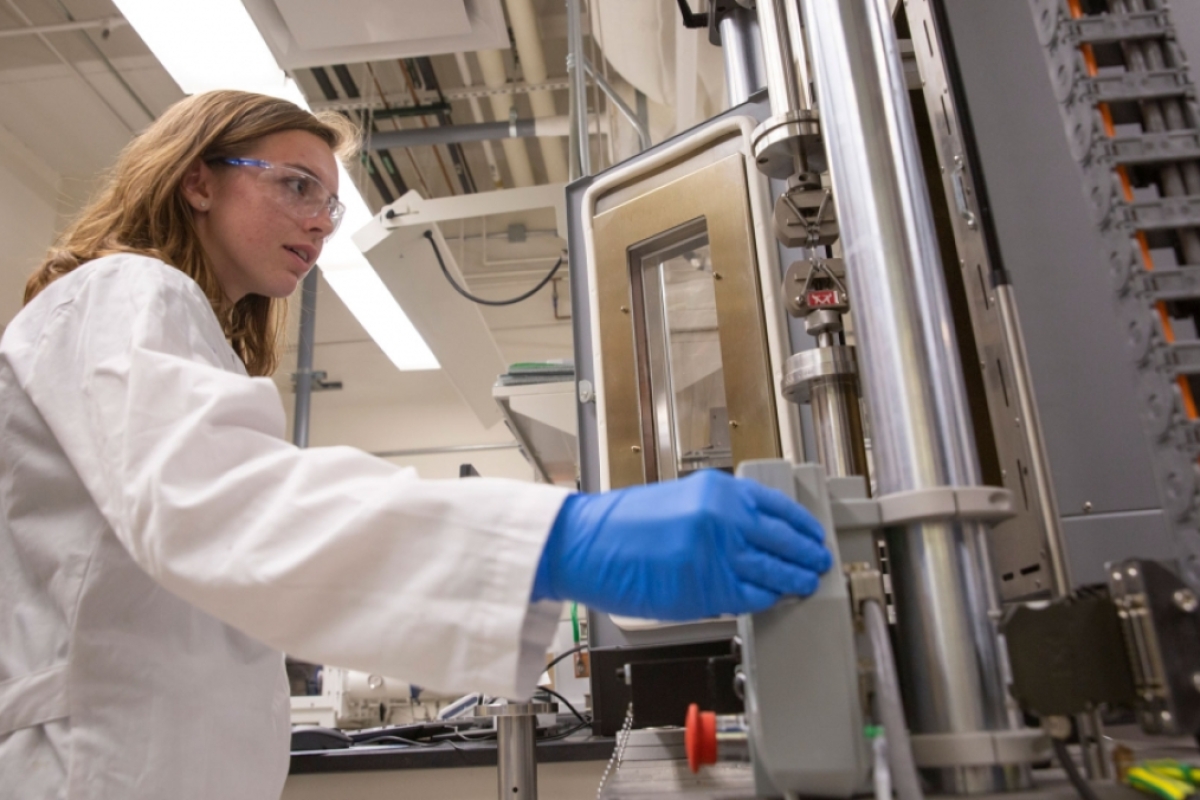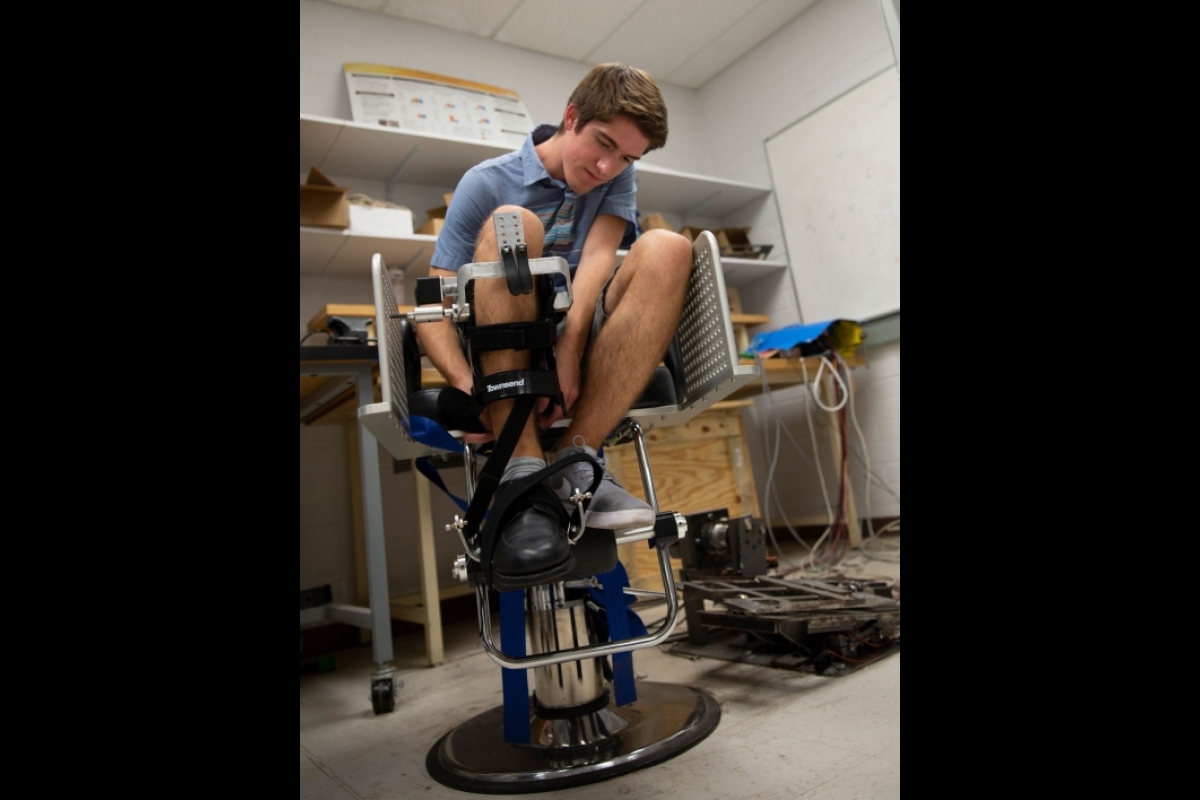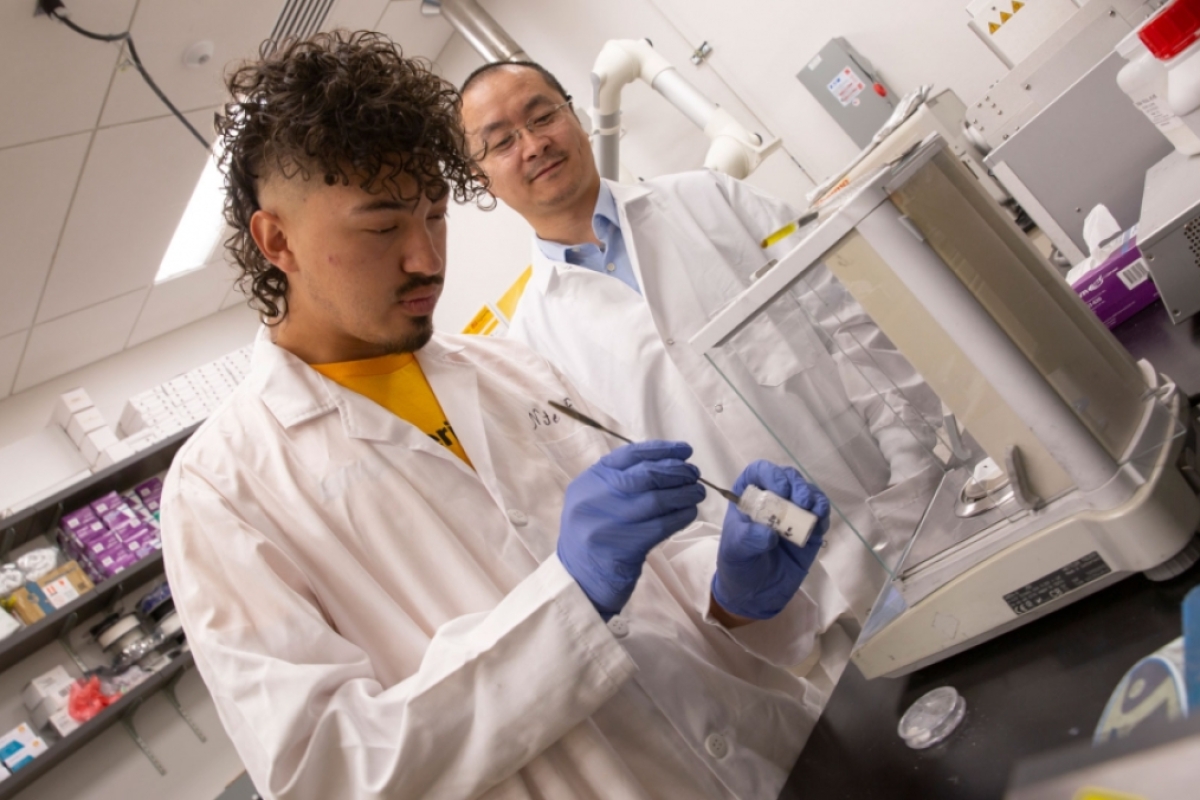Funding, freedom, flexibility: Graduate research fellowship helps students pursue passions

The National Science Foundation Graduate Research Fellowship Program supports outstanding science and engineering students in their pursuit of research-based master’s and doctoral degrees at the U.S. university of their choice. Each year, students from the Ira A. Fulton Schools of Engineering at Arizona State University are selected for the fellowship, and students from other institutions choose to attend the Fulton Schools to conduct research. Graphic by Erika Gronek/ASU
Fostering the next generation of science and engineering professionals is imperative for the United States to advance technologically and address complex challenges to the health and prosperity of its people.
Students from the Ira A. Fulton Schools of Engineering at Arizona State University have been identified by the National Science Foundation Graduate Research Fellowship Program, or GRFP, as future leaders in academia and industry who can enable these advances. For 70 years, the program has helped to expand and diversify domestic talent in science, technology, engineering and math, or STEM, fields.
The fellows — selected for their accomplishments and potential to “contribute significantly to research, teaching and innovations in science and engineering” — can choose to pursue STEM research-based master’s or doctoral degrees at a U.S. university of their choice. Administered at ASU by the Graduate College, recipients earn a $34,000 stipend over three years. A supplemental $12,000 allowance assists fellows with tuition, fees and other education and professional development expenses.
At least 11 students who graduated with bachelor’s degrees from the Fulton Schools earned NSF Graduate Research Fellowships in 2022, and three students from other institutions have chosen to attend the Fulton Schools to conduct their fellowship research.
Receiving this fellowship is a high honor. The funding to focus on research, freedom to choose the school they attend and flexibility to explore topics that interest them make the NSF GRFP the ultimate opportunity. While Fulton Schools-affiliated NSF Graduate Research Scholars are scattered across the country in pursuit of their dreams, they share a dedication to build upon their research experience, become pioneers in exciting fields, collaborate on interdisciplinary research and foster diversity in STEM fields.
Leveraging research opportunities
Fulton Schools undergraduate students leverage a variety of opportunities to kick-start their interests in research and make them attractive candidates for NSF Graduate Research Fellowships.
Alexis Hocken, who earned a bachelor’s degree in chemical engineering from the Fulton Schools, got involved in research right away. She joined Associate Professor Matthew Green’s lab as a first-year student and participated in the Fulton Undergraduate Research Initiative to pursue impactful research in polymer nanocomposites.
“Throughout undergrad, I had always expected myself to pursue polymers with a bio focus,” Hocken says. “However, during my last semester at ASU, I took Professor Tim Long’s sustainable macromolecules class, which opened my eyes to a whole other side of polymers. It interested me enough that I decided to select a polymers project related to sustainability for my graduate research.”
As a biomedical engineering major, Esther Sim’s undergraduate research experience at the Fulton Schools spanned three different labs and the disciplines of synthetic biology, genetic engineering and systems biology.
She discovered a passion for tissue engineering during a summer internship with the National Institutes of Health’s 3D Tissue Bioprinting Lab at the National Center for Advancing Translational Sciences. Her project involved developing a 3D vascularized tissue model for lung cancer drug screening.
“While I had been in research for a few years up until this point, my internship truly opened my eyes to the kind of research that really awakened and inspired me,” Sim says. “Previous projects had fascinated me, but this one made me voraciously hungry to do more, learn more. That was when I decided that tissue engineering research was the best fit for my personality and interests.”
Maggie Cook completed an undergraduate degree in biomedical engineering and a minor in biochemistry this past spring and participated in research throughout her four years at ASU. She was encouraged to pursue the NSF GRFP by her faculty mentors she met while working on her research projects.
“My mentors, Drs. Chris Plaisier, Ben Bartelle and Emma Frow, were relentlessly supportive of my research goals and academic pursuits,” Cook says. “I owe my selection as a fellow in no small part to their guidance.”
Hocken, Sim and Cook are taking the skills and interests they’ve developed to other institutions for their NSF Graduate Research Fellowships. Hocken is attending the Massachusetts Institute of Technology, Sim is beginning a joint program with the University of California, Berkeley and the University of California, San Francisco, and Cook is conducting research at the University of Washington.
Exciting new directions
The freedom to choose any university and the flexibility to pursue their own interests means NSF Graduate Research Fellows are focusing on research at the forefront of exciting fields, like wearable robotics and additive manufacturing.
After earning a bachelor’s degree in mechanical engineering and a master’s degree in robotics and autonomous systems from ASU, James Arnold took his research experience with Associate Professor Hyunglae Lee’s Neurorobotics Lab and the innovative ideas he cultivated there to the Harvard Biodesign Lab because of its focus on translating high quality research ideas into reality.
“(The Harvard Biodesign Lab) allows me to continue my work on the control of wearable robotics while focusing on how such devices work in the real world,” he says. “I believe that wearable sensing/estimation techniques coupled with recent advances in soft robotics have the potential to help a lot of people in the near future.”
Nathan Fonseca is pursuing research in the exciting field of additive manufacturing to develop a membrane for higher-efficiency water purification.
“I am from Ecuador and come from a rural background where clean water isn’t always available,” says Fonseca, who earned a bachelor’s degree in mechanical engineering from ASU. “Therefore, being able to provide cost-effective and faster production methods for water filtration systems is our goal. We aim to positively impact countries like Ecuador, Afghanistan, Ethiopia, Pakistan and many more that suffer from the lack of basic water necessities.”
Fonseca chose to stay at ASU for his fellowship research because of the support of his faculty mentors and the extensive resources offered by the Fulton Schools.
“The additive manufacturing facilities, as well as the Simulator Building (on ASU’s Polytechnic campus), were things that captivated me,” he says.
Pursuing interdisciplinary research
Many of the Fulton Schools-affiliated NSF Graduate Research Fellows are choosing to pursue research in highly interdisciplinary topics, building upon their education in multiple disciplines and exploring topics that span engineering fields.
Rachael T. Kha brings an interdisciplinary background to her research, having earned bachelor’s degrees in philosophy and economics in addition to chemical engineering bachelor’s and master’s degrees from ASU.
“During undergrad, I also thought a lot about my interests in the humanities and social sciences, and whether or not the diversity of my academic background could be useful in whatever career I chose,” Kha says.
She was introduced to interdisciplinary research through her work with Professor Daniel Rivera, which focused on control systems applications for behavioral medicine.
“Dr. Rivera’s work in control systems allowed me to continue working within the engineering school while actively engaging with the ideas that I found interesting in other fields,” Kha says.
In the fall, she’s headed to MIT for its social and engineering systems doctoral program, which she selected because it was “interdisciplinary by nature, as students are required to take courses across engineering, computer science and social sciences, as well as probability and statistics,” Kha says.
Rachel Newton earned bachelor’s degrees in electrical engineering and computational mathematical sciences from ASU and a master’s degree in electrical engineering from the University of Michigan - Ann Arbor. Now beginning her doctoral research into wind farm control optimization techniques, she has a great sense of confidence in her own abilities as a researcher, especially in interdisciplinary topics.
“I am motivated by interdisciplinary research,” Newton says, “and my focus area crosses two of the subdisciplines of electrical engineering that are most interesting to me, so it was a natural starting point for my graduate research.”
Fostering diversity
One goal of the NSF GRFP is to diversify STEM leadership. Many fellows bring diverse perspectives to their research and seek to make the benefits of engineering more accessible to underrepresented communities.
Kelsie Herzer discovered she was interested in social activism during her undergraduate years studying chemical engineering at the University of New Mexico. She found the environmental engineering graduate program at ASU combined her engineering background and passion for environmental and social justice.
The NSF GRFP will allow her to make more of an impact in her research, which focuses on bioremediation. She has already demonstrated the importance of her work in her first year of graduate work at ASU. While teaching an environmental microbiology course, Herzer added discussion on the topic of environmental racism, in which policies cause some racial communities to be disproportionally affected by land contaminated by hazardous waste.
“Environmental racism is an important topic that is often overlooked in engineering discourses,” Herzer says. “Changing the curriculum at ASU is a big step in the right direction, toward dismantling current systems of power and institutionalized racism. I hope to conduct research that is not only novel, but also has a tangible impact and can be implemented to benefit the Black and brown communities that are overburdened with environmental contamination.”
Rachel Figard came to ASU as a graduate student after earning a bachelor’s degree in industrial engineering from North Carolina State University.
“I wanted to be at a school that supports and encourages novelty and creativity in research. ASU’s commitment to innovation demonstrated to me that I would be supported in that along my PhD journey,” she says. “Most importantly, I wanted an adviser that I felt like I could connect with and would support me along the way. My adviser, (Associate Professor Adam Carberry), along with the ASU faculty at large, have been so supportive throughout my first year.”
Figard’s research seeks to help engineering students with disabilities by exploring their experiences with technology usability. She used her own lived experiences, background and identity in her NSF GRFP proposal.
“As an individual who has experienced discrimination for my gender and ability status, I want to create a space for others like me who may not have a voice,” Figard says. “I have constantly encountered instances where my access has hindered me in reaching my goals. This being true for me means that it is also preventing others as well, which drives me to change the paradigm.”
Receiving an NSF Graduate Research Fellowship is important to Figard because it has shown her that “those outside the disabled community recognize the marginalization of people with disabilities and want to provide the funding to help address it.”
More Science and technology

ASU researcher part of team discovering ways to fight drug-resistant bacteria
A new study published in the Science Advances journal featuring Arizona State University researchers has found…

ASU student researchers get early, hands-on experience in engineering research
Using computer science to aid endangered species reintroduction, enhance software engineering education and improve semiconductor…

ASU professor honored with prestigious award for being a cybersecurity trailblazer
At first, he thought it was a drill.On Sept. 11, 2001, Gail-Joon Ahn sat in a conference room in Fort Meade, Maryland.…


